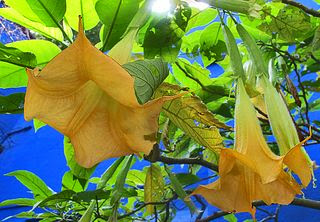Type of Flower
Datura:
Datura is a genus of nine species of vespertine flowering plants belonging to the family Solanaceae. They are known as angel's trumpets, sometimes sharing that name with the closely related genus Brugmansia, and commonly as daturas. They are also sometimes called moonflowers, one of several plant species to be so. Its precise and natural distribution is uncertain, owing to its extensive cultivation and naturalization throughout the temperate and tropical regions of the globe. Its distribution within the Americas and North Africa, however, is most likely restricted to the United States and Mexico in North America, and Tunisia in Africa, where the highest species diversity occurs.
Some South American plants formerly thought of as Datura are now treated as belonging to the distinct genus Brugmansia (Brugmansia differs from Datura in that it is woody, making shrubs or small trees, and it has pendulous flowers, rather than erect ones). Other related genera include Hyoscyamus and Atropa.
Datura species are herbaceous, leafy annuals and short-lived perennials which can reach up to 2 m in height. The leaves are alternate, 10–20 cm long and 5–18 cm broad, with a lobed or toothed margin. The flowers are erect or spreading (not pendulous like those of Brugmansia), trumpet-shaped, 5–20 cm long and 4–12 cm broad at the mouth; colors vary from white to yellow, pink, and pale purple. The fruit is a spiny capsule 4–10 cm long and 2–6 cm broad, splitting open when ripe to release the numerous seeds. The seeds disperse freely over pastures, fields and even wasteland locations.
Datura belongs to the classic "witches' weeds", along with deadly nightshade, henbane, and mandrake. Most parts of the plants contain toxic hallucinogens, and datura has a long history of use for causing delirious states and death. It was well known as an essential ingredient of love potions and witches' brews.
The word datura comes from the sanskrit dhatūr ("thorn apple"); In Sanskrit it is referred as "Kanak" and "Unmatt" in the ancient scriptures of Indian Ayurveda by sage Sushrut and Charaka. Record of this name in English dates back to 1662.Nathaniel Hawthorne refers to one type in The Scarlet Letter as apple-Peru. In Mexico, its common name is toloache.
The larvae of some Lepidoptera (butterfly and moth) species, including Hypercompe indecisa, eat some Datura species.
Datura species are usually planted annually from the seed produced in the spiny pods, but with care, plants can be overwintered. Most species are suited to being planted outside or in containers. As a rule, they need warm, sunny places and soil that will keep their roots dry. When grown outdoors in good locations, the plants tend to reseed themselves and may become invasive. In containers, they should have porous, aerated potting soil with adequate drainage. The plants are susceptible to fungi in the root area, so organic enrichment such as compost and manure should be avoided.
It is difficult to classify Datura as to its species, and it often happens that the descriptions of new species are accepted prematurely. Later, these "new species" are found to be simply varieties that have evolved due to conditions at a specific location. They usually disappear in a few years. Contributing to the confusion is the fact that various species, such as D. wrightii and D. inoxia, are very similar in appearance, and the variation within a species can be extreme. For example, Datura species can change size of plant, leaf, and flowers, all depending on location. The same species, when growing in a half-shady, damp location can develop into a flowering bush half as tall as a person, but when growing in a very dry location, will only grow into a thin plant not much more than ankle-high, with tiny flowers and a few miniature leaves.

























Hi There, thanks so much for this post! I'm wondering if you can help me? My new yellow Datura has started developing soft browning rings on the ends of the trumpet flowers. Any ideas why? It also seems to have slowed production of new flowers.
ReplyDelete